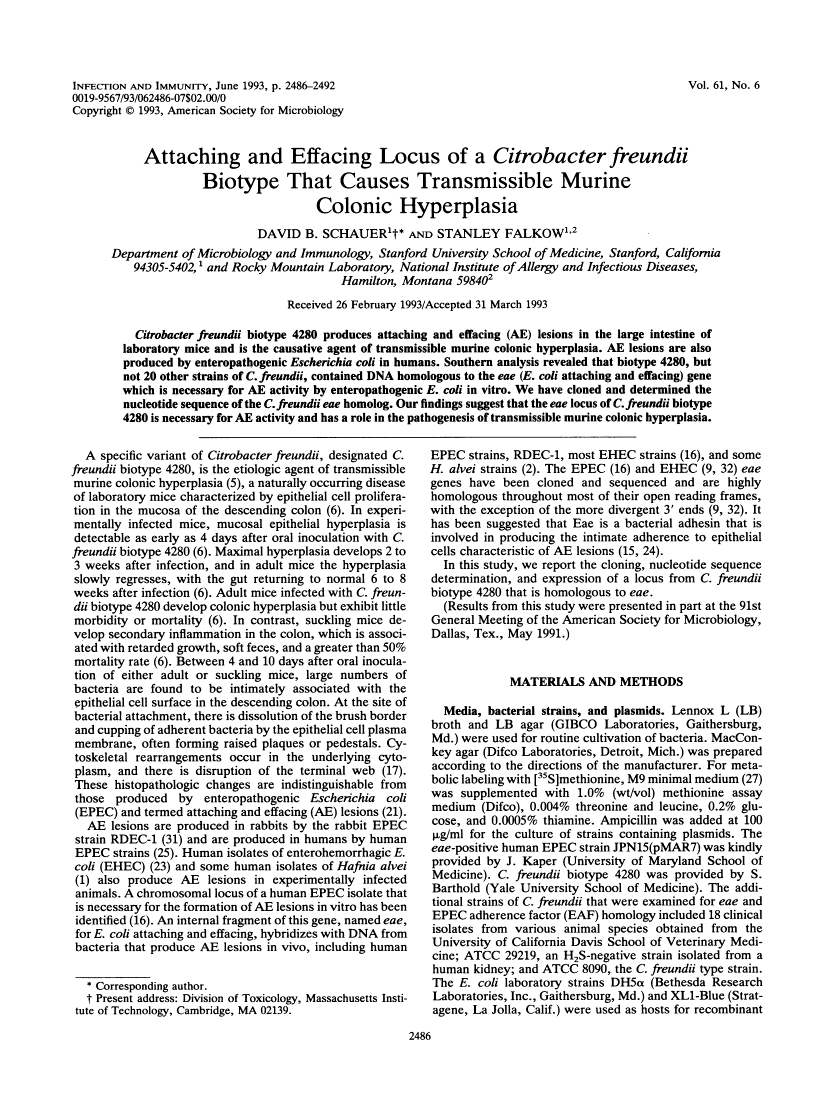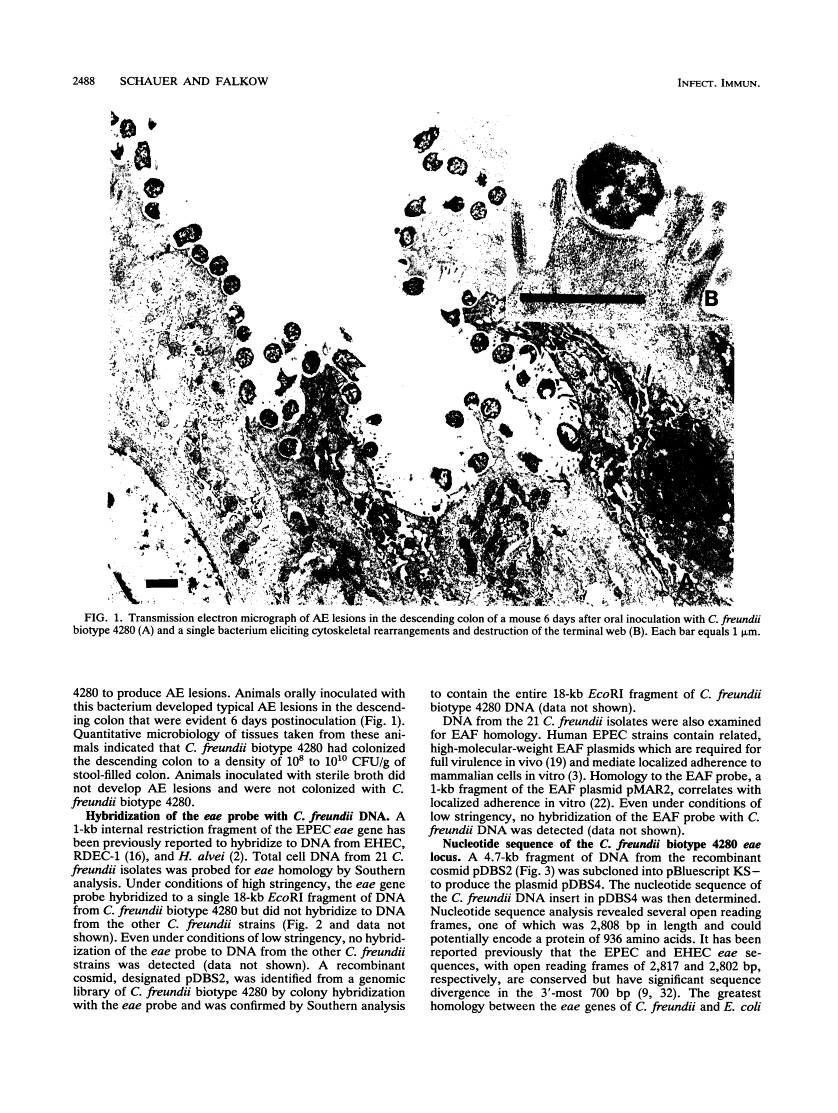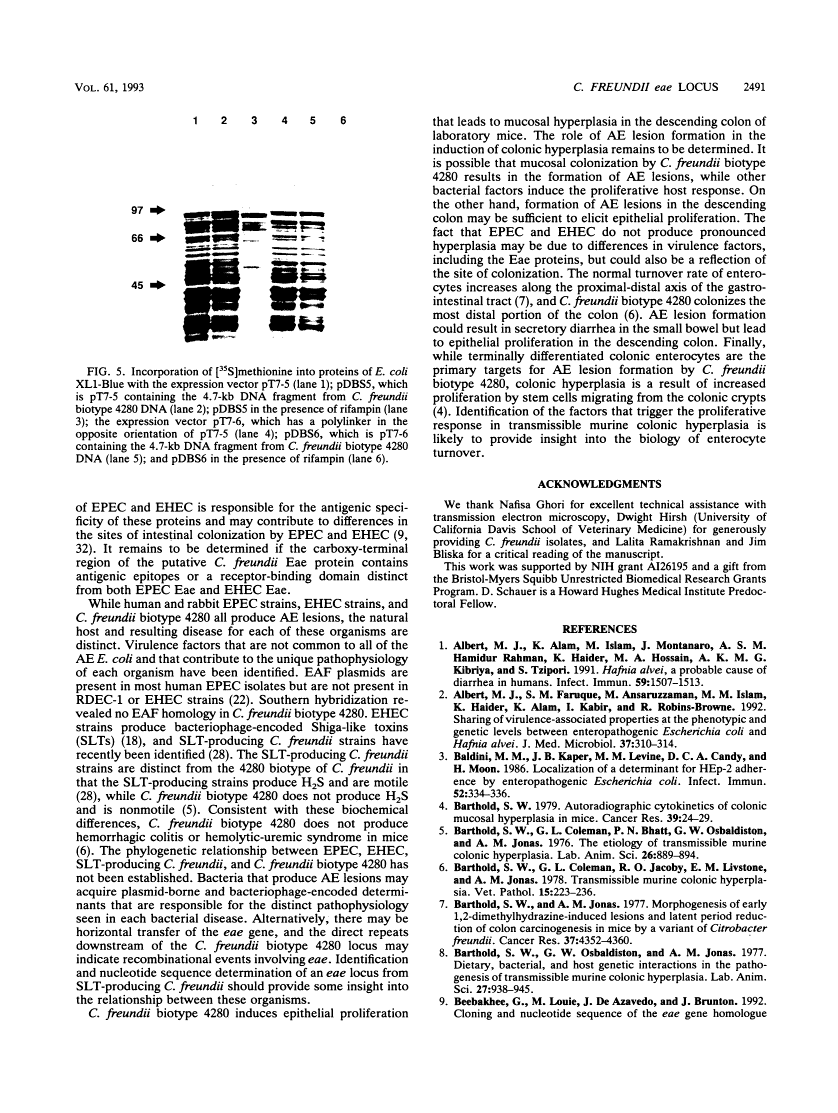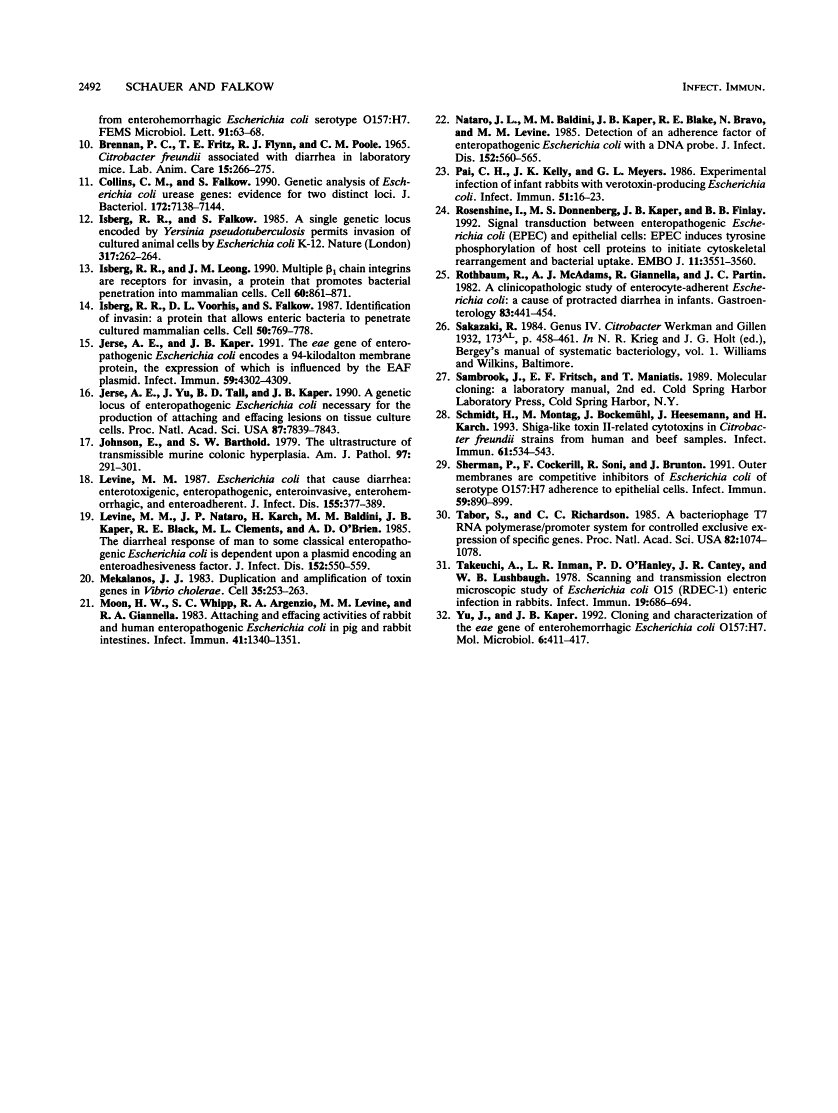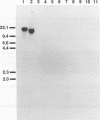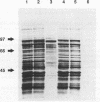Abstract
Free full text

Attaching and effacing locus of a Citrobacter freundii biotype that causes transmissible murine colonic hyperplasia.
Abstract
Citrobacter freundii biotype 4280 produces attaching and effacing (AE) lesions in the large intestine of laboratory mice and is the causative agent of transmissible murine colonic hyperplasia. AE lesions are also produced by enteropathogenic Escherichia coli in humans. Southern analysis revealed that biotype 4280, but not 20 other strains of C. freundii, contained DNA homologous to the eae (E. coli attaching and effacing) gene which is necessary for AE activity by enteropathogenic E. coli in vitro. We have cloned and determined the nucleotide sequence of the C. freundii eae homolog. Our findings suggest that the eae locus of C. freundii biotype 4280 is necessary for AE activity and has a role in the pathogenesis of transmissible murine colonic hyperplasia.
Full text
Full text is available as a scanned copy of the original print version. Get a printable copy (PDF file) of the complete article (1.8M), or click on a page image below to browse page by page. Links to PubMed are also available for Selected References.
Images in this article
Selected References
These references are in PubMed. This may not be the complete list of references from this article.
- Albert MJ, Alam K, Islam M, Montanaro J, Rahaman AS, Haider K, Hossain MA, Kibriya AK, Tzipori S. Hafnia alvei, a probable cause of diarrhea in humans. Infect Immun. 1991 Apr;59(4):1507–1513. [Europe PMC free article] [Abstract] [Google Scholar]
- Albert MJ, Faruque SM, Ansaruzzaman M, Islam MM, Haider K, Alam K, Kabir I, Robins-Browne R. Sharing of virulence-associated properties at the phenotypic and genetic levels between enteropathogenic Escherichia coli and Hafnia alvei. J Med Microbiol. 1992 Nov;37(5):310–314. [Abstract] [Google Scholar]
- Baldini MM, Nataro JP, Kaper JB. Localization of a determinant for HEp-2 adherence by enteropathogenic Escherichia coli. Infect Immun. 1986 Apr;52(1):334–336. [Europe PMC free article] [Abstract] [Google Scholar]
- Barthold SW. Autoradiographic cytokinetics of colonic mucosal hyperplasia in mice. Cancer Res. 1979 Jan;39(1):24–29. [Abstract] [Google Scholar]
- Barthold SW, Coleman GL, Bhatt PN, Osbaldiston GW, Jonas AM. The etiology of transmissible murine colonic hyperplasia. Lab Anim Sci. 1976 Dec;26(6 Pt 1):889–894. [Abstract] [Google Scholar]
- Barthold SW, Coleman GL, Jacoby RO, Livestone EM, Jonas AM. Transmissible murine colonic hyperplasia. Vet Pathol. 1978 Mar;15(2):223–236. [Abstract] [Google Scholar]
- Barthold SW, Jonas AM. Morphogenesis of early 1, 2-dimethylhydrazine-induced lesions and latent period reduction of colon carcinogenesis in mice by a variant of Citrobacter freundii. Cancer Res. 1977 Dec;37(12):4352–4360. [Abstract] [Google Scholar]
- Barthold SW, Osbaldiston GW, Jonas AM. Dietary, bacterial, and host genetic interactions in the pathogenesis of transmissible murine colonic hyperplasia. Lab Anim Sci. 1977 Dec;27(6):938–945. [Abstract] [Google Scholar]
- BRENNAN PC, FRITZ TE, FLYNN RJ, POOLE CM. CITROBACTER FREUNDII ASSOCIATED WITH DIARRHEA IN A LABORATORY MICE. Lab Anim Care. 1965 Aug;15:266–275. [Abstract] [Google Scholar]
- Collins CM, Falkow S. Genetic analysis of Escherichia coli urease genes: evidence for two distinct loci. J Bacteriol. 1990 Dec;172(12):7138–7144. [Europe PMC free article] [Abstract] [Google Scholar]
- Isberg RR, Falkow S. A single genetic locus encoded by Yersinia pseudotuberculosis permits invasion of cultured animal cells by Escherichia coli K-12. Nature. 1985 Sep 19;317(6034):262–264. [Abstract] [Google Scholar]
- Isberg RR, Leong JM. Multiple beta 1 chain integrins are receptors for invasin, a protein that promotes bacterial penetration into mammalian cells. Cell. 1990 Mar 9;60(5):861–871. [Abstract] [Google Scholar]
- Isberg RR, Voorhis DL, Falkow S. Identification of invasin: a protein that allows enteric bacteria to penetrate cultured mammalian cells. Cell. 1987 Aug 28;50(5):769–778. [Abstract] [Google Scholar]
- Jerse AE, Kaper JB. The eae gene of enteropathogenic Escherichia coli encodes a 94-kilodalton membrane protein, the expression of which is influenced by the EAF plasmid. Infect Immun. 1991 Dec;59(12):4302–4309. [Europe PMC free article] [Abstract] [Google Scholar]
- Jerse AE, Yu J, Tall BD, Kaper JB. A genetic locus of enteropathogenic Escherichia coli necessary for the production of attaching and effacing lesions on tissue culture cells. Proc Natl Acad Sci U S A. 1990 Oct;87(20):7839–7843. [Europe PMC free article] [Abstract] [Google Scholar]
- Johnson E, Barthold SW. The ultrastructure of transmissible murine colonic hyperplasia. Am J Pathol. 1979 Nov;97(2):291–313. [Europe PMC free article] [Abstract] [Google Scholar]
- Levine MM. Escherichia coli that cause diarrhea: enterotoxigenic, enteropathogenic, enteroinvasive, enterohemorrhagic, and enteroadherent. J Infect Dis. 1987 Mar;155(3):377–389. [Abstract] [Google Scholar]
- Levine MM, Nataro JP, Karch H, Baldini MM, Kaper JB, Black RE, Clements ML, O'Brien AD. The diarrheal response of humans to some classic serotypes of enteropathogenic Escherichia coli is dependent on a plasmid encoding an enteroadhesiveness factor. J Infect Dis. 1985 Sep;152(3):550–559. [Abstract] [Google Scholar]
- Mekalanos JJ. Duplication and amplification of toxin genes in Vibrio cholerae. Cell. 1983 Nov;35(1):253–263. [Abstract] [Google Scholar]
- Moon HW, Whipp SC, Argenzio RA, Levine MM, Giannella RA. Attaching and effacing activities of rabbit and human enteropathogenic Escherichia coli in pig and rabbit intestines. Infect Immun. 1983 Sep;41(3):1340–1351. [Europe PMC free article] [Abstract] [Google Scholar]
- Nataro JP, Baldini MM, Kaper JB, Black RE, Bravo N, Levine MM. Detection of an adherence factor of enteropathogenic Escherichia coli with a DNA probe. J Infect Dis. 1985 Sep;152(3):560–565. [Abstract] [Google Scholar]
- Pai CH, Kelly JK, Meyers GL. Experimental infection of infant rabbits with verotoxin-producing Escherichia coli. Infect Immun. 1986 Jan;51(1):16–23. [Europe PMC free article] [Abstract] [Google Scholar]
- Rosenshine I, Donnenberg MS, Kaper JB, Finlay BB. Signal transduction between enteropathogenic Escherichia coli (EPEC) and epithelial cells: EPEC induces tyrosine phosphorylation of host cell proteins to initiate cytoskeletal rearrangement and bacterial uptake. EMBO J. 1992 Oct;11(10):3551–3560. [Europe PMC free article] [Abstract] [Google Scholar]
- Rothbaum R, McAdams AJ, Giannella R, Partin JC. A clinicopathologic study of enterocyte-adherent Escherichia coli: a cause of protracted diarrhea in infants. Gastroenterology. 1982 Aug;83(2):441–454. [Abstract] [Google Scholar]
- Schmidt H, Montag M, Bockemühl J, Heesemann J, Karch H. Shiga-like toxin II-related cytotoxins in Citrobacter freundii strains from humans and beef samples. Infect Immun. 1993 Feb;61(2):534–543. [Europe PMC free article] [Abstract] [Google Scholar]
- Sherman P, Cockerill F, 3rd, Soni R, Brunton J. Outer membranes are competitive inhibitors of Escherichia coli O157:H7 adherence to epithelial cells. Infect Immun. 1991 Mar;59(3):890–899. [Europe PMC free article] [Abstract] [Google Scholar]
- Tabor S, Richardson CC. A bacteriophage T7 RNA polymerase/promoter system for controlled exclusive expression of specific genes. Proc Natl Acad Sci U S A. 1985 Feb;82(4):1074–1078. [Europe PMC free article] [Abstract] [Google Scholar]
- Takeuchi A, Inman LR, O'Hanley PD, Cantey JR, Lushbaugh WB. Scanning and transmission electron microscopic study of Escherichia coli O15 (RDEC-1) enteric infection in rabbits. Infect Immun. 1978 Feb;19(2):686–694. [Europe PMC free article] [Abstract] [Google Scholar]
- Yu J, Kaper JB. Cloning and characterization of the eae gene of enterohaemorrhagic Escherichia coli O157:H7. Mol Microbiol. 1992 Feb;6(3):411–417. [Abstract] [Google Scholar]
Associated Data
Articles from Infection and Immunity are provided here courtesy of American Society for Microbiology (ASM)
Full text links
Read article at publisher's site: https://doi.org/10.1128/iai.61.6.2486-2492.1993
Read article for free, from open access legal sources, via Unpaywall:
https://iai.asm.org/content/iai/61/6/2486.full.pdf
Free after 4 months at iai.asm.org
http://iai.asm.org/cgi/reprint/61/6/2486
Free to read at iai.asm.org
http://iai.asm.org/cgi/content/abstract/61/6/2486
Citations & impact
Impact metrics
Citations of article over time
Alternative metrics

Discover the attention surrounding your research
https://www.altmetric.com/details/124522226
Article citations
Both pathogen and host dynamically adapt pH responses along the intestinal tract during enteric bacterial infection.
PLoS Biol, 22(8):e3002761, 15 Aug 2024
Cited by: 1 article | PMID: 39146372 | PMCID: PMC11349234
Why put yourself on a pedestal? The pathogenic role of the A/E pedestal.
Infect Immun, 92(9):e0048923, 09 Apr 2024
Cited by: 2 articles | PMID: 38591884 | PMCID: PMC11384751
Review Free full text in Europe PMC
Citrobacter rodentium possesses a functional type II secretion system necessary for successful host infection.
Gut Microbes, 16(1):2308049, 01 Jan 2024
Cited by: 1 article | PMID: 38299318 | PMCID: PMC10841016
HOIL1 Regulates Group 3 Innate Lymphoid Cells in the Colon and Protects against Systemic Dissemination, Colonic Ulceration, and Lethality from Citrobacter rodentium Infection.
J Immunol, 211(12):1823-1834, 01 Dec 2023
Cited by: 1 article | PMID: 37902285
Quorum sensing modulates bacterial virulence and colonization dynamics of the gastrointestinal pathogen Citrobacter rodentium.
Gut Microbes, 15(2):2267189, 16 Oct 2023
Cited by: 0 articles | PMID: 37842938 | PMCID: PMC10580866
Go to all (181) article citations
Data
Data behind the article
This data has been text mined from the article, or deposited into data resources.
BioStudies: supplemental material and supporting data
Similar Articles
To arrive at the top five similar articles we use a word-weighted algorithm to compare words from the Title and Abstract of each citation.
The eae gene of Citrobacter freundii biotype 4280 is necessary for colonization in transmissible murine colonic hyperplasia.
Infect Immun, 61(11):4654-4661, 01 Nov 1993
Cited by: 130 articles | PMID: 8406863 | PMCID: PMC281217
Molecular pathogenesis of Citrobacter rodentium and transmissible murine colonic hyperplasia.
Microbes Infect, 3(4):333-340, 01 Apr 2001
Cited by: 189 articles | PMID: 11334751
Review
Citrobacter rodentium, the causative agent of transmissible murine colonic hyperplasia, exhibits clonality: synonymy of C. rodentium and mouse-pathogenic Escherichia coli.
J Clin Microbiol, 38(12):4343-4350, 01 Dec 2000
Cited by: 58 articles | PMID: 11101562 | PMCID: PMC87603
Intimin from enteropathogenic Escherichia coli restores murine virulence to a Citrobacter rodentium eaeA mutant: induction of an immunoglobulin A response to intimin and EspB.
Infect Immun, 64(12):5315-5325, 01 Dec 1996
Cited by: 76 articles | PMID: 8945583 | PMCID: PMC174525
